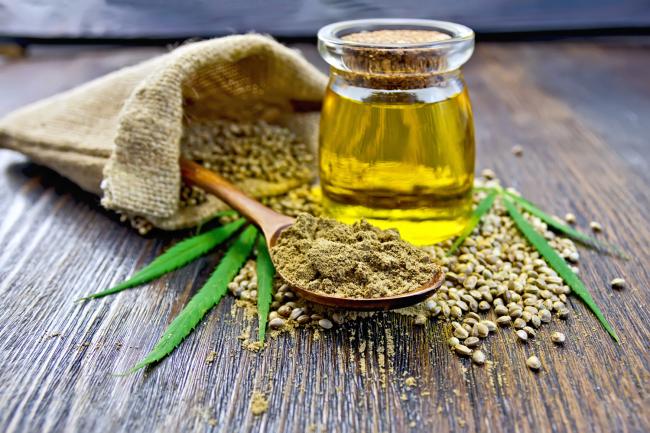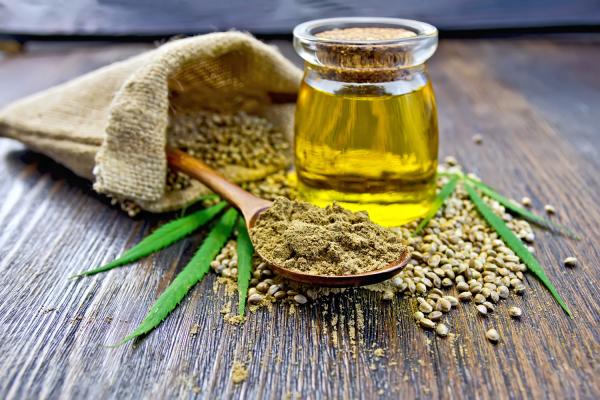Hemp residues - reuse for food and energy recovery with oils

The SCARABEO project introduces an innovative approach aimed to the by-products diversification and waste valorization of hemp stems.
• Retting wastes valorisation by polyphenols extraction for food or pharmaceutical end use;
• Stalk woody core agronomic exploitation by carbonization, for biochar and enriched biochar production;
• Stalk woody core energetic exploitation by carbonization and syngas (fuel) production;
• Fiber clean out wastes valorization by their conversion in larval biomass for biodiesel and
biogas production
• Stalks skutching and carbonization of the woody inner core for the production of biochar (mulcher) and syngas (fuel);
• Bast fiber retting, chemical characterization of the retting mixture, and phenolics compound extraction for food and /or pharmaceutical end use. Enriched biochar production by retting waste clarification through biochar filters;
• Retted fibre clean up by BSF larvae controlled digestion and use of the larval biomass for biodiesel and protein panels production, useful for biogas production.
• Agronomic trials for enriched biochar evaluation as mulcher.
1) MANAGEMENT ACTION (STUARD, SSICA, UCSC, CFSIVT, SCVSA)
Stuard will assume the role of coordinator of the GO, planning and implementing all the initiatives required to achieve the results provided by the Plan For this reason, it will employ its own, technical and administrative staff, qualified and equipped with multi-year experience in the coordination of research, experimentation and dissemination project activities.
The staff will operate in accordance with specific management procedures and operational to ensure a proper conduct of the activties (staff training, evaluation of suppliers, implementation of project activities, verification and assessment of compliance of the operations and results obtained with respect to the expected results).
From the operational point of view, Stuard as Head of Plan (RP) will coordinate:
• overall activities;
• animation and dissemination actions, described in the plan.
2) STUDY ACTIONS NEEDED FOR THE IMPLEMENTATION OF THE PLAN (MARKET, FACTORY, BUSINESS PLAN, ECC): (SCVSA)
The aim is to evaluate the economic sustainability of the project for agronomic, energetic and food use of the products obtained through digestate treatment. The alternative use of digestate, proposed under this project, involves a significant reduction in the management and environmental costs of cogeneration residues and market value enhancement of the products resulting from the conversion process of such residues, such as ammonium salts, biochar, thermal energy, and polyphenols usable in food supplementation. In addition in order to have a positive impact on the economy of the agro-energy supply chain, the project will result in a number of beneficial effects on human well-being through the generation of positive externalities.
Costs and benefits will be assessed at every level of the chain in the perspective of optimizing, in a long-term perspective, the economic efficiency of technological transformation
Action 3.1 Harvesting and stocking and stemming hemp stems (Stuard, and Farms)
Harvesting of hemp stems will be carried out mainly by the Agricola Freppoli Giuseppe, with the supervision of the experts of the experimental Stuard farm, but will also be carried out at the other two agricultural farm partners of the project. This operation will be carried out with the use of mowing and roto-packing machines with the ability to wrap the collected biomass (rotoballe) to store the material outdoors, protecting it from any fermentation processes. These rocket blades will then be sewn at fiber separation plants. At these plants, about 15% of fiber will be harvested, and about 85% will be a cannula (woody marrow) with a small portion of fiber, which will be transferred to big bag at the site of the micro carbonizing prototype to be carbonized.
Action 3.2 Phenol maceration / extraction (Stuard, CREA, CFSIVT, UCSC)
Maceration is the process that allows the separation and extraction of fibers from the surrounding tissues through the digestion of the pectic component and other cementing substances, operated by the macerant flora that is naturally found on the hemp stems. The innovation developed by Errani on the maceration pad consists of the mechanical pretreatment of the stems which, compared to the traditional method of maceration of the whole stems, reduces:
- the amount of water needed for the process
- maceration times
- the amount of waste produced and the environmental impact of the process
Action 3.3 Treatment of macerated hemp fiber with larvae breeding (Stuard, UCSC, CREA, CFSIVT)
The breeding of specimens of the Hermitia illucens and the subsequent use of the larvae for the reduction of mucilage substances retained on hemp fiber, macerated in Action 3.2, is one of the most experimental phases of the process proposed in this project.
The choice to develop within the project, both the breeding phase and the real utilization of larvae and their subsequent energy enhancement for the production of biodiesel and biogas, is motivated by the desire to monitor all phases of the life cycle insects, the various physical / environmental parameters related to their activity and quantify their yield in the production of biofuels. This information is indispensable in order to have valid and concrete indications of possible economic feasibility for any future industrialization phases of the system.
Action 3.4 Canapulo carbonization (CFSIVTEE, SITEIA)
At CFSIVT (Tadini) there is an innovative micro carboniser (patent WO 215/018742), equipped with a specific feeding system for farm residues from farms, which is provided in a Free-to-use Convenience. The prototype is a micro carboniser for civilian use or for Small Medium Business, in a modular scale, allowing the use of a single unit or larger modules.
The technological innovation of the product consists in the possibility of carbonizing, without pretreatment, waste materials from the agro-food chains as a sustainable source of thermal and electrical energy, using a dual power supply and a control system that optimizes the proportions of input materials. But true innovation lies in the product obtained by carbonization, a process that converts organic matter into a source of renewable energy (syngas), with biochar production to be used as an amyloniser for carbon sequestration in agricultural soils (with increased yields, sequestration of contaminants, greater retention capacity), or possibly usable in air and water filtration
Action 3.5 Agronomic Tests (Stuard, and Farms)
The experimentation will last two years, the trial fields will be carried out at farms starting in spring 2018. Farms will be involved in soil preparation, sowing and crop management in accordance with good agricultural practices of PPE in collaboration with agricultural technicians Experimental Stuard.
Stuard Experiment Experts will assist and assist farmers during soil preparation, planting, and plant management for the entire duration of the project while collaborating on biochar distribution. The Stuard Experimental Farm will also focus on the test setting and definition of the experimental protocol, the choice of varieties to be included in the experimental fields, the design of field patterns and seed detection, as well as the distribution of the various fertilizer matrices collaboration, where necessary, with farms.
Action 3.6 Laboratory Analysis (UCSC, SITEIA)
FANOLE ESTRANTS FROM MACERATION LIQUID
After the analysis, a confirmation of the identification of compounds by structural correlation with the molecular correlation structure (tandem mass spectrum) will also be conducted. In addition to the UHPLC / QTOF analysis, a characterization of the volatile component of the maceration liquid through mass gas chromatography coupled to mass spectrometry (HSGC / MS) will be performed, and the spectra after deconvolution will be identified through commercial libraries.
Analysis of biochar for its use as an adjunct (SITEIA.PARMA)
The international guidelines outline the requirements that the biochar must have in order to be utilized in agriculture as an adjunct. SITEIA. PARMA will undertake basic analyzes for the biochar characterization during the project prior to its application in field trials, providing useful information to guide the phases of the experiment.
Action 3.7 Draft annual reports, detailing the technical and managerial details of each business test and the results achieved (year by year) (STUARD, UCSC, CFSIVT, SCVSA)
For each of the companies and actions, a report will be drawn up by the partners who will annually record all the results obtained and will be the basis of any improvements to be introduced for the following year.
Action 3.8 Drawing Guidelines for Application and Spreading Practices and / or Combination of Test Practices. (STUARD)
At the end of the planning period, a technical and agronomic account will be produced of the activity carried out in each company, showing the successes and possible failures of the tested techniques in the different types of soil. The aim is to provide a reading key that can make the contextualization of the practices easier, even and above all, depending on the company's features.
Action 3.9 Data collection and LCA (STUARD, CREA, UCSC, Tadini, SITEIA)
Parameter control of maceration process
Sampling evaluation agronomic enhancement
Sampling evaluation of energy enhancement
Sampling Food Valuation Evaluation
Sample environmental impact assessment and LCA
4) DISSEMINATION ACTION
During the SCARABEO project various dissemination and communication activities will be planned and carried out in order to inform the stakeholders about the objectives of the project and the achieved results, allowing them to be transferred.
This action will be based on the following activities:
- Spreading Plan and Strategy: Stuard (CF) Company together with the Scientific Responsible (RS) and the Partners' Responsibilities of G.O. will prepare a detailed planning of communication and dissemination activities, identifying the most appropriate goals andmeans of communication, modulating both the times and the actions to be taken;
- Definition of visual identity of the project: in order to make the SCARABEO project easily recognizable, the image will be coordinated, in line with the objectives of the project and the PSR 2014-2020. Visual identity will include:
• The logo of the project,
• The template for presentations, for PDF documents (to be used for press releases, reports, etc.), for brochures and other dissemination material,
All awareness and promotion material will then report the SCARABEO program logo and the references of the contribution of the PSR Regione Emilia Romagna 2014-2020;
- Dissemination of the intermediate and final results of the project to the press and the media:SCARABEO project partners, in co-ordination with the Head of Rails and the Scientific
Manager, will use the main channels of communication and the network to work with the media in order to guarantee better dissemination of project results.
| Titolo/Descrizione | Url | Tipologia |
|---|---|---|
|
Sito web del progetto
|
Sito web
|
|
|
Linee Guida per la coltivazione della Canapa da seme e da fibra
|
Materiali utili
|
|
|
Relazione tecnica finale
|
Materiali utili
|
|
|
Video evento del 1 marzo 2019
|
Materiali utili
|
